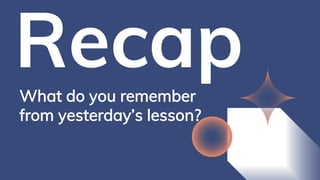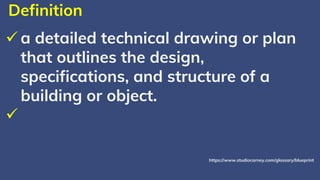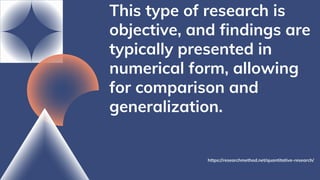Exploring the Different Types of Experimental Research
- 1. What do you remember from yesterday’s lesson?
- 2. What do we call this drawing?
- 3. Definition ✓ a plan or design that explains how something might be achieved https://dictionary.cambridge.org/dictionary/english/blueprint
- 4. Definition ✓ a detailed technical drawing or plan that outlines the design, specifications, and structure of a building or object. ✓ https://www.studiocarney.com/glossary/blueprint
- 5. Definition ✓ serves as a strategic plan or detailed outline used to guide the development and execution of a project. https://www.studiocarney.com/glossary/blueprint
- 7. Quantitative research methods are essential for understanding trends and making informed decisions based on data analysis.
- 8. Quantitative research quantifies data and generalizes results from a sample to a larger population. It relies on structured data collection methods and employs statistical analysis to interpret results.
- 9. This type of research is objective, and findings are typically presented in numerical form, allowing for comparison and generalization. https://researchmethod.net/quantitative-research/
- 10. TYPES OF EXPERIMENTAL RESEARCH Experimental research involves rigorous testing to establish cause- and-effect relationships. It includes true experiments, quasi- experimental designs, and various pre- experimental methods that test hypotheses in controlled settings.
- 11. Experimental Research ✓ manipulates one or more variables (independent variable) to see its effect on another variable (dependent variable) while controlling other factors. ✓ aims to establish cause-and-effect relationships.
- 12. Characteristics ✓ Manipulates variables ✓ Controls other variables ✓ Random assignment of participants
- 14. True Experimental Design Involves random assignment, ensuring validity and reliability of results through controlled conditions. 1.Manipulation of Independent Variable (IV) 2.Presence of control group 3.Random assignment of participants
- 15. Example RQ: Does the use of Chat GPT as a writing strategy improve Grade 12 students’ writing performance compared to traditional classroom instruction? IV: use of Chat GPT DV: students’ writing performance
- 16. Example Design: One hundred students are randomly assigned to two groups. Group A (used Chat GPT) and Group B (traditional classroom instruction). Measure the writing performance for both sections after one quarter.
- 17. Quasi-Experimental Design Similar to true experimental but lacks random assignment. Groups are often pre- existing or naturally formed. Used when random assignment is not feasible or ethical. 1.Manipulation of Independent Variable (IV) 2.Often has a control group (or comparison group) 3.No random assignment
- 18. Example RQ: Does the use of Chat GPT as a writing strategy improve Grade 12 students’ writing performance compared to traditional classroom instruction? IV: use of Chat GPT DV: students’ writing performance
- 19. Example Design: Two existing Grade 12 classes are used. Section A is taught using Chat GPT and Section B is taught using the traditional method. Measure the writing performance for both sections after one quarter.
- 20. Pre-Experimental Design Considered the weakest form of experimental design which involves manipulation of the IV but lacks either a control group or random assignment (or both). Therefore, it has very limited internal validity and cannot truly establish cause-and- effect.
- 22. One-Shot Case Study Implement a treatment and then observe the effect. A new training program (treatment) is given to employees, and then their productivity is measured. (no pretest, no control group).
- 23. One-Group Pretest-Posttest Design Measure a group before treatment, apply the treatment, then measure the group again. Students take a pre- test on math, then participate in a 3- week intensive math tutorial, then take a post-test. (No control group, so other factors might explain changes).
- 24. Static-Group Comparison One group receives a treatment, and another pre- existing group (not randomly assigned) does not. The two groups are then compared. Compare the performance of students who participated in an after-school tutoring program (treatment group) with those who did not (comparison group) using existing records. (No random assignment, pre-existing group)
























